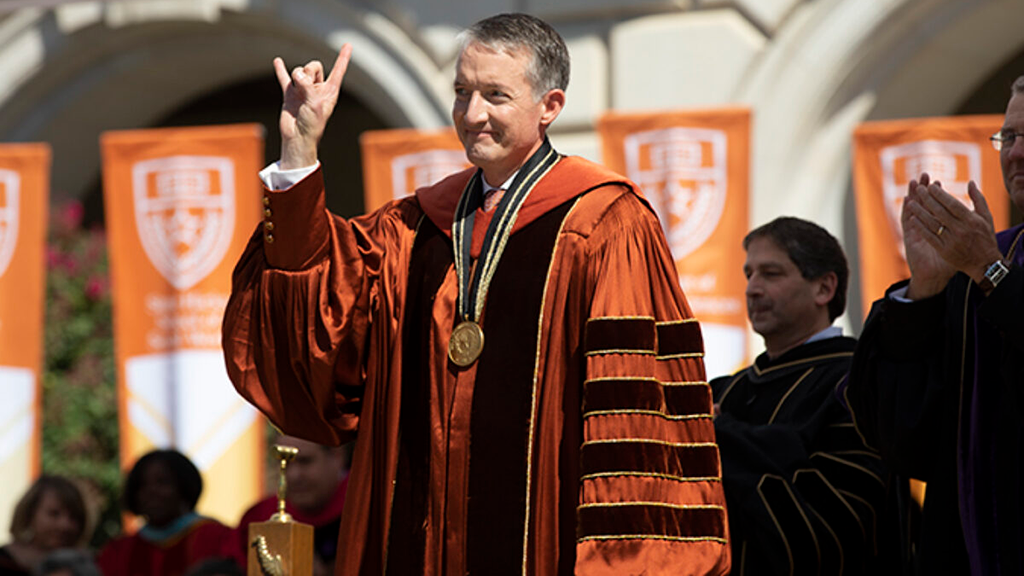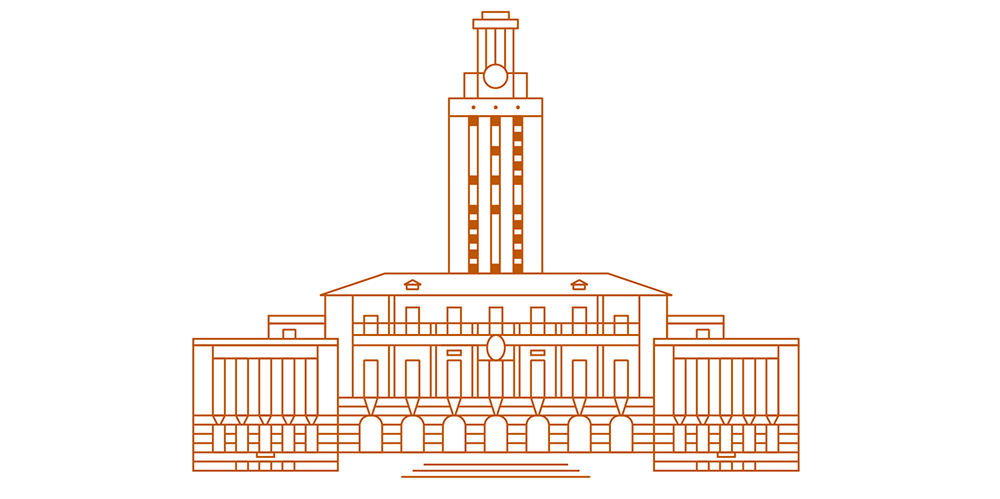Light the Tower: Inauguration of President Jay Hartzell

The UT Tower will shine with burnt orange lights and “30” displayed on its sides on Friday, September 24 to celebrate the formal inauguration of Jay Hartzell as the 30th president of The University of Texas at Austin.
Hartzell was appointed president last year, but his official inauguration was postponed due to the pandemic. He previously served as the 12th dean of the McCombs School of Business and has been a member of the UT Austin faculty since 2001.
Members of the UT community gathered at the Tower on Friday for the inauguration and Hartzell’s State of the University address.
In his address, Hartzell, who was joined by faculty members, administrators and regents, outlined a vision for the university that has grown out of a campus-wide strategic planning process. He said The University of Texas at Austin will become the world’s highest-impact public university by focusing and strengthening what sets UT Austin apart – its people, its place and its pursuits.
“There’s no reason that we shouldn’t be one of the world’s leading academic engines for innovation, new companies and future jobs,” he said. “If we combine our talent base, our strengths in STEM fields, our emerging expertise in health care, our connections both with our alumni base and state and local ecosystems, we’ll have a huge impact in ways that are hard to even predict.”

The first part of his vision, he said, begins with investing in the people who work for UT and continuing to cultivate a diverse and inclusive community.
“We create the greatest impact by focusing on our people, taking advantage of our place and honing our pursuits,” Hartzell said. “We can better utilize our breadth and scale to help our staff find growth opportunities on our campus and in many cases, stay here for their entire careers.”
Moving forward, Hartzell said the university will pursue initiatives that will provide staff members with greater opportunities to learn, develop and add skills, upgrade various HR and IT systems around campus, and work to create an actionable and ambitious plan for the entire campus that focuses on “people, place and pursuits.”
Some aspects of this goal are already being achieved. This fall, the university is serving more students from historically underrepresented groups than ever before, following a record number of freshman applications from Black and Hispanic students. First-generation students now make up nearly a quarter of the undergraduate student body with nearly 9,400 students a year.
In regard to place or location, Austin is an economic engine, an incubator for creativity and a center for nonprofits and think tanks. Hartzell said that the university will work to embrace these unique advantages even more. The university will also soon unveil a new technology commercialization initiative, which will include a new set of programs, practices and resources for engagement with industry partners and alumni.
I don’t want to wake up in 10 years and see that we didn’t do enough, didn’t rise up, or didn’t take enough risks… I’m confident we’ll plot a course to become the world’s most impactful public university.”
— President Jay Hartzell
Finally, Hartzell outlined the types of research and teaching activities UT will pursue to maximize impact. Teaching pursuits include reinvigorating campus life, core curriculum and community engagement. UT will also more heavily involve its 550,000 alumni to create additional mentoring and networking opportunities for students.
UT will double down on immersive education with two broad themes: investing in more interdisciplinary programs and better training students to be more entrepreneurial. Hartzell pointed to a few early examples: the Master of Arts in Design Health program, a collaboration between the Dell Medical School and the College of Fine Arts, and entrepreneurial initiatives such as a new entrepreneurship minor, the Kendra Scott Women’s Entrepreneurial Leadership Institute and the Harkey Institute for Entrepreneurship.
“It’s not enough to think about how to teach – we must also continue to innovate in terms of what we teach,” Hartzell said. “We need more of these hubs – cross-functional, interdisciplinary and experiential in nature – so we can train the next generation of leaders to solve the next set of problems facing our world.”
Hartzell concluded by talking about research pursuits.
“From advanced materials to AI, we know that basic research will always underpin groundbreaking research. But I want us to be known for both,” he said. “To use a baseball metaphor, we’re seeking a research and scholarship culture that produces more home runs, and not just more singles and doubles.”
Woven throughout his remarks were the key themes of optimism in regard to UT’s unique assets and opportunities, and boldness in regard to how the university moves forward.
“I don’t want to wake up in 10 years and see that we didn’t do enough, didn’t rise up, or didn’t take enough risks,” he said. “We have an incredible chance to bring together amazing, diverse talent at scale, to utilize Austin and Texas even as we serve them better, and to innovate in our classrooms and performance spaces, our archives, libraries and labs. If we can do that, I’m confident we’ll plot a course to become the world’s most impactful public university.”